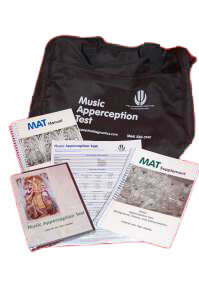Please specify the quantity of product(s).



Music Apperception Test (MAT)
| Item | Product | Price | QTY |
|---|---|---|---|
| 35100 | Music Apperception Test (MAT) Kit | $160.00 | |
| 35100C | MAT Compact Disc | $60.00 | |
| 35100M | MAT Manual | $38.00 | |
| 35100R | MAT Record Forms, Pk/20 | $38.00 | |
| 35100S | MAT Supplement: Background, Theory & Interpretation | $28.00 |
Non-visual Projective Assessment with Objective Scoring to Assess Communication and Executive Functions
Author: Leland Van Den Daele
A World of Information from One Test
The Music Apperception Test (MAT) is an individually administered test of verbal and creative ability, fantasy production, emotion recognition and empathy, response to stress, and defensiveness. The MAT arises from the "music projective technique" that requires subjects to "tell a story to music." Music for the MAT was composed specially to represent primary emotions. The portrayed emotions range from "interest" and "joy" to "terror" and "disgust".
The MAT engages subjects in relaxed reverie, analogous to daydreaming, guided by the music experience. Like dreams, reverie to music is associated with visual imagery and unfolds over time.
Extensive Research Basis
The MAT builds upon four decades of research and experience with normal and clinical populations. Children, adolescents, adults, persons from diverse cultures, and patients in psychoanalytic therapy were tested with music from different parts of the world and historical periods. Experience from these studies revealed dramatic individual differences in responsiveness, cognitive style, vigilance, defense, and dispositional mood. "Apperception" captures this broad range of application since it includes perception and its determinants.
Key Features of the MAT
- The MAT is time efficient. Administration time for the Standard Test, including instructions, is about 21 minutes. The test has standardized prerecorded instructions
- The test includes several versions to fit different diagnostic and research needs, a Short Form A and B, a Standard Form, and an Extended Form
- The MAT readily engages the interest of children from six years old, adolescents, and adults
- The Test provides real-time measures that relate to real-world adaptation and self- presentation
- The MAT is designed to evaluate change of performance in time as a measure of coping with stress and uncertainty.
The MAT introduces new and important indicators of individual differences:
- "Multiprocessing Tolerance" identifies the capacity to simultaneously listen to music and respond.
- "Narrative Style" describes different "global" approaches to description and engagement with stimuli. These include "Kinetic/ lmagistic ", "Balanced ", "Logical", and "Disorganized"
- "Affective Fit" provides a multilevel measure of emotional attunement to compositions.
- "Tangential Response" identifies the degree of evasiveness and defensiveness.
Norms
Percentile ranks based on a normative sample of children, adolescents, and adults are available in the MAT Manual for Response Latency, Fluency, and Content. The instrument possesses high internal consistency and test-retest reliability for its ratio scale measures. Probability distributions and cut-off scores based on research and clinical observations are provided for its ordinal measures.
Scoring and Interpretation
The MAT may be scored by hand or by trained personnel. Record Forms are available to calculate and graphically display results. The MAT contains 34 different scales. The Major indices are:
- Response Latency
- Fluency (Three measures)
- PACE
- Content (Ten categories)
- Types of Interaction (Four types)
- Tangential Response (Three categories)
- Affective Fit (Five factors)
- Narrative Style (Four types)
- Morbid Content
- Adaptive Response to Change
- Time to Termination
The MAT Manual and MAT Supplement provide guidelines and examples for scoring and interpretation.
The MAT is a potent tool for:
- Observation of how respondents impose meaning upon emotionally laden ambiguous stimuli;
- Appraisal of narrative style and tailoring of interventions;
- Assessment of special populations, especially the blind and visually impaired;
- Evaluation of persons from diverse environmental and cultural backgrounds.
- Since the test does not rely upon pictorial images, respondents create their own characters, plots, and settings.
The MAT greatly increases accuracy in diagnostic appraisal and treatment planning by:
- Eliciting clients' "frameworks of meaning", dispositional moods, emotional blockages, psychodynamics, and defenses;
- Establishing convergent validity.
The MAT powerfully addresses special diagnostic purposes that include:
- Assessment of alexethymia and autistic spectrum disorders;
- Neuro psychological evaluation of cross-modal hemispheric transfer, synesthesia, and amusica;
- Clinical and educational evaluation of children and adolescents for impulsivity and executive control;
- Forensic checks on dissimulation since MAT responses are not easily faked.
The MAT uniquely assesses the ability for rapid general integration of cognitive-affective inputs essential to:
- Occupational evaluation of person nel when quickness, fluency, creativity, and capacity for emotional understanding are important;
- Gauging narrative ability and flexibility for vocational decisions.
The MAT Kit comes with the MAT CD, MAT Manual, MAT Record Forms Pk/20, and MAT Supplement.
Get more information about the MAT here.

MAT Introduction
Your browser does not support the video tag.